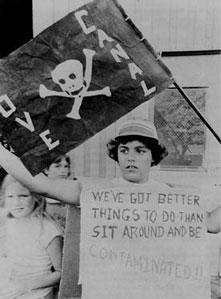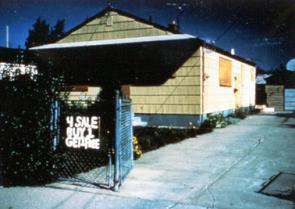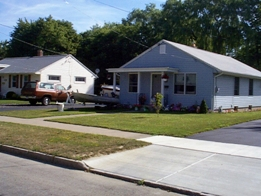
Tuesday, November 22, 2011
Saturday, November 19, 2011
Bhopal Gas Tragedy - semua orang kena tahu dan ingat. jgn biarkan ia berulang
- berlaku pada malam 2-3 desember 1984 di kilang racun serangga, union carbide india limited, terletak di Bhopal, madya pradesh, india.
- pada malam tersebut, air telah memasuki tangki simpanan cecair kimia Methyl Isicyanate (MIC) yang telah menyebabkan berlakunya tindak balas exorthermic sekaligus membuatkan suhu dan tekanan didalam tangki meningkat.
- secara automatik paip melepaskan tekanan akan berfungsi lalu gas MIC akan disalurkan kepada alat kawalan pencemaran (scrubber) untuk menapis/menyerap gas berbahaya.
- walaubagaimanapun pada malam tersebut sistem alat kawalan pencemaran tersebut tidak berfungsi. dikatakan pihak kilang menutup sistem itu untuk menjimatkan kos.
- gas beracun yang terbebas dari kilang itu ditiupkan angin kearah bhopal yang menyebabkan ribuan penduduknya terbunuh.
- ironinya tiada seorangpun yang berada di kilang tersebut terbunuh.
Friday, November 18, 2011
Dasar Alam Sekitar Malaysia
National Policy on the Environment which integrates the three elements of sustainable development: economic, social and cultural development and environmental conservation was formulated and approved in 2002. The Policy aims at continued economic, social and cultural progress and enhancement of the quality of life of Malaysians hrough environmentally sound and sustainable development. It is based on eight (8) inter-related and mutually supporting principles set to harmonise economic development goals with environmental imperatives:
- Stewardship of the Environment
- Conservation of Nature’s Vitality and Diversity
- Continuous Improvement in the Quality of the Environment
- Sustainable Use of Natural Resources
- Integrated Decision-Making
- Role of the Private Sector
- Commitment and Accountability
- Active Participation in the International Community
In keeping abreast with the country’s rapid economic development and to meet with the nation’s aspiration for an improved quality of life, the National policy on the Environment serves as an important guide to all stakeholders to ensure that the environment is clean, safe, healthy and productive.
klau nak baca lengkap sila tekan sini
kalau like sila tekan sini
Wednesday, November 9, 2011
AIR POLLUTANT INDEX (API) INDEKS PENCEMAR UDARA (IPU) 09-11-2011 (Wednesday)
7:00AM
API | Status | Areas | % |
| 0-50 | Good | 47 | 92% |
| 51-100 | Moderate | 4 | 7% |
| 101-200 | Unhealthy | 0 | 0% |
| 201-300 | Very Unhealthy | 0 | 0% |
| >301 | Hazardous | 0 | 0% |
11:00AM
API | Status | Areas | % |
| 0-50 | Good | 47 | 92% |
| 51-100 | Moderate | 4 | 7% |
| 101-200 | Unhealthy | 0 | 0% |
| 201-300 | Very Unhealthy | 0 | 0% |
| >301 | Hazardous | 0 | 0% |
5:00PM
API | Status | Areas | % |
| 0-50 | Good | 46 | 90% |
| 51-100 | Moderate | 5 | 9% |
| 101-200 | Unhealthy | 0 | 0% |
| 201-300 | Very Unhealthy | 0 | 0% |
| >301 | Hazardous | 0 | 0% |
| NEGERI / STATE | KAWASAN/AREA | MASA/TIME 7:00AM | MASA/TIME 11:00AM | MASA/TIME 5:00PM |
| Johor | Kota Tinggi | 61* | 61* | 59* |
| Johor | Larkin Lama | 34* | 34* | 32* |
| Johor | Muar | 33* | 40c | 66c |
| Johor | Pasir Gudang | 57* | 58* | 58* |
| Kedah | Alor Setar | 30* | 34* | 35* |
| Kedah | Bakar Arang, Sg. Petani | 41* | 43* | 42* |
| Kedah | Langkawi | 33* | 37* | 37* |
| Kelantan | M. Sult. Ismail, K. Bharu | 31* | 31* | 39c |
| Kelantan | Tanah Merah | 47* | 47* | 46* |
| Melaka | Bandaraya Melaka | 28* | 30* | 46c |
| Melaka | Bukit Rambai | 51* | 52* | 52* |
| Negeri Sembilan | Nilai | 43* | 45* | 45* |
| Negeri Sembilan | Port Dickson | # | 41* | 38* |
| Negeri Sembilan | Seremban | 37* | # | 50c |
| Pahang | Balok Baru, Kuantan | 29* | 33* | 37* |
| Pahang | Indera Mahkota, Kuantan | 43* | 45* | 45* |
| Pahang | Jerantut | 33* | 33* | 32* |
| Perak | Jalan Tasek, Ipoh | 27* | 27* | 33c |
| Perak | Kg. Air Putih, Taiping | 34* | 37* | 31* |
| Perak | S K Jalan Pegoh, Ipoh | 48* | 48* | 45* |
| Perak | Seri Manjung | 35* | 39* | 39* |
| Perak | Tanjung Malim | 22* | 23* | 38c |
| Perlis | Kangar | 27* | 30* | 29* |
| Pulau Pinang | Perai | 41* | 42* | 43* |
| Pulau Pinang | Seberang Jaya 2, Perai | 49* | 50* | 50* |
| Pulau Pinang | USM | 22* | 27c | 26* |
| Sabah | Keningau | 27* | 25* | 26* |
| Sabah | Kota Kinabalu | 23* | 23* | 29c |
| Sabah | Sandakan | 27* | 27* | 42c |
| Sabah | Tawau | 41* | 38* | 39* |
| Sarawak | Bintulu | 52* | 52* | 51* |
| Sarawak | ILP Miri | 34* | 34* | 19* |
| Sarawak | Kapit | 36* | 36* | 34* |
| Sarawak | Kuching | 46* | 42* | 41* |
| Sarawak | Limbang | 25* | 26* | 25* |
| Sarawak | Miri | 45* | 45* | 44* |
| Sarawak | Samarahan | 36* | 34* | 34* |
| Sarawak | Sarikei | 33* | 32* | 33* |
| Sarawak | Sibu | 37* | 30* | 30* |
| Sarawak | Sri Aman | 39* | 39* | # |
| Selangor | Banting | 38* | 39* | 42c |
| Selangor | Kuala Selangor | 35* | 35* | 36* |
| Selangor | Pelabuhan Kelang | 34* | 33* | 33* |
| Selangor | Petaling Jaya | 43* | 43* | 43* |
| Selangor | Shah Alam | 33* | 34* | 34* |
| Terengganu | Kemaman | 35* | 45c | 36c |
| Terengganu | Kuala Terengganu | 35* | 34* | 34* |
| Terengganu | Paka | 22* | 24* | 24* |
| Wilayah Persekutuan | Batu Muda,Kuala Lumpur | 30* | 29* | 29c |
| Wilayah Persekutuan | Cheras,Kuala Lumpur | 46* | 47* | 48* |
| Wilayah Persekutuan | Labuan | 36* | 36* | 35* |
| Wilayah Persekutuan | Putrajaya | 24* | 27c | 30c |
Nota / Note * = Habuk Halus (PM10) c = Ozon (O3) a = Sulfur Dioksida (SO2) d = Karbon Monoksida (CO) b = Nitrogen Dioksida (NO2) & = Lebih daripada satu pencemarp/s: kalau like tekan sini
Tuesday, November 8, 2011
The Tragedy of the Love Canal- kisah pengurusan sisa toksik yang buat orang sengsara



William T. Love came to 1890s Niagara Falls, New York, with hugely ambitious plans. The landowner and entrepreneur envisioned the creation of an enormous utopian metropolis. His city would be home to enviable industry, and housing for more than a million people. Thousands of acres would become “the most extensive and beautiful [park] in the world”. He planned to power the city using hydroelectric dams on a new 11-kilometer canal between the upper and lower Niagara Rivers. Within a year, however, Love’s plans failed, and would quickly have been forgotten if it weren’t for one problem.
The one part of Love’s city that had been built was a kilometer-long pit that would have been a part of the canal. After a few decades, this pit was purchased by the City of Niagara Falls, which had decided that it would make an ideal location for a needed chemical-dumping site. After the pit was filled with waste, a neighborhood was built directly on top of it. By the 1970s, the Love Canal became the site of one of the worst environmental disasters in American history.
Back in 1892, it seemed inconceivable that Love’s plans would fall apart so dramatically. He was a driven and charismatic man, who filled his brochures with wild promises and other hyperbole. The idea of a new city “among the greatest manufacturing cities in the United States” drew many supporters and investors; the following year saw construction begin on the canal. Then Love’s ideas were quashed fairly quickly by a combination of factors. The fluctuations of the economy scared off the investors; the discovery of how electricity could be efficiently transmitted over long distances made Love’s canal seem unnecessary; and local politicians prohibited the diversion of the rivers’ water altogether. And thus Love’s ambitions evaporated almost overnight.
The pit remained, filling with rainwater and becoming a local recreation area: swimming in the summer, skating in the winter. In 1920 the land was sold to nearby Niagara Falls, a growing industrial town that immediately started using the pit as a dumping ground for chemical wastes. This continued for more than twenty years, after which the Hooker Chemical and Plastics Corporation (now a part of Occidental Petroleum or OxyChem) purchased the land for their own chemical disposal. By 1953, the company had buried nearly 22,000 tons of waste, and the pit was virtually full.
At that time, the dangers of chemical wastes were almost entirely unknown. Far from being alarmed or even wary of living next to a major chemical producer, the city’s residents were delighted at the medical and other developments that the chemical industry was bringing in. No one thought that the same companies could engage in any potentially dangerous activities. The Love Canal was lined with clay and covered with dirt to supposedly seal it, and Hooker Chemical’s experts declared it safe. Only the occasional scientist recognized the dangers of chemical waste in the 1940s. One, a Dr. Robert Mobbs, had explored the link between insecticides and cancer; he would later strongly denounce Hooker Chemical as not just careless but also aware of the potential for danger in its dumping ground.
It is not certain whether Hooker suspected the potential effects of its waste products. However, the fact that the company sold the Love Canal land for a single dollar is suspicious. So is the carefully-worded disclaimer that Hooker included with the sale, disclaiming any responsibility for side-effects from chemical exposure.
Either way, these subtle warnings were not the red flag they should have been. The Niagara Falls Board of Education, which was in urgent need of more classroom space, eagerly purchased the land and began constructing a new elementary school. In 1955, four hundred children began attending the school, as about 100 homes were built in the surrounding areas. Although most of the residents of Niagara Falls knew what the land had been previously used for, they were not cautioned about living on it.
Unsurprisingly, the direct effects of the pit’s contents were soon felt. Strange odors and substances were reported by residents, especially those with basements. Pieces of phosphorus made their way to the surface; children in the schoolyard were burned by toxic waste. Local officials were alerted, but took no action.
In 1976, water from heavy rains and a record-breaking blizzard caused a significant amount of chemical waste to migrate to the surface, where it contaminated the entire neighborhood. In the following years the area was stricken with higher than normal rates of stillborn births and miscarriages, and many babies were born with birth defects. Informal studies at this time noted the frightening trend. One, by the Agency for Toxic Substances and Disease Registry, observed more than 400 types of chemicals in the air, water, and soil, with some of them – such as benzene – already known to be carcinogenic.
One particular family that was affected was that of local mother Lois Gibbs. After reading about the history of the Love Canal in a local publication, she realized that her young son Michael had been constantly ill since starting at the new school. Gibbs asked for her son to be transferred; when this failed, she went from door to door in her neighborhood with a petition to close the school. The situation turned out to be even worse than she had thought; her rounds made it clear that the entire neighborhood was ill. Gibbs went on to lead the campaign to call attention to the neighborhood; she was joined by many other local parents as well as the editors of the Niagara Falls Gazette.
Finally, in the spring of 1978, state health commissioner Dr. Robert P. Whalen declared the area around the Love Canal hazardous. The school closed, the land was sectioned off, and more than 200 families in the immediate area were evacuated. By August of that year, the hazardous site was receiving national attention. On 7 August, President Jimmy Carter called upon the Federal Disaster Assistance Agency for its help. In September, Dr. Whalen released an intensive report on the disaster, which read in part:
The profound and devastating effects of the Love Canal tragedy, in terms of human health and suffering and environmental damage, cannot and probably will never be fully measured…[w]e cannot undo the damage that has been wrought at Love Canal but we can take appropriate preventive measures so that we are better able to anticipate and hopefully prevent future events of this kind.
Evacuation from the Love Canal neighborhood.Lawsuits were quick to arrive, and Hooker Chemical found itself being sued for more than $11 billion. The corporation denied its involvement through this series, even when faced by the Federal Justice Department in 1979 and New York State in 1989.
Still, a great deal of damage had been done, and eventually more than 1,000 families had to be moved out of the Love Canal area. An EPA study revealed that of the thirty-six people tested, eleven had chromosomal damage; and that of fifteen Love Canal babies born between January 1979 and January 1980, only two were healthy. Agencies at the state and federal levels spent hundreds of millions of dollars trying to clean up the pollution. Of that, Hooker Chemical has eventually been persuaded to contribute about $130 million.
One good thing that came out of the disaster was the creation of the Comprehensive Environmental Response, Compensation, and Liability Act, more commonly known as the ‘Superfund’ law. Its aim is to collects taxes from gas and chemical corporations to be used directly to clean up any sites similar to the Love Canal. OxyChem now lists ‘making chemical plants safer and more environmentally sound’ as one of its goals.
Houses in the area today.There is a sad irony in the fact that the site of William T. Love’s “most perfect city in existence” became home to such a disaster. In the last fifteen years, however, there has been some gradual resettlement of the Love Canal site. In the early 1990s parts of the area were declared safe again, and now make up a neighborhood known as Black Creek Village. The area was taken off the Superfund list in September 2004 at the announcement that certain clean-up goals had been reached. Much of the Canal itself, however, remains sectioned off by a chain-link fence, which to any local passersby must serve as a poignant reminder of the whole catastrophe.
p/s: kalau like tekan sini
Wednesday, November 2, 2011
sistem baru pengurusan schedule waste / toxicant hazardous waste

- e-consignment note
- sistem baru untuk menggantikan sistem nota konsinan untuk mengesan pergerakan buangan terjadual/schedule waste/ toxicant hazardous waste sehingga dilupuskan di premis yang ditetapkan yang dilesenkan oleh jabatan alam sekitar.
- rasionalnya adalah untuk menggatikan sistem lama yang menggunakan terlalu banyak borang. skarang hanya klik klik dan klik.
- akan dienforcekan menjelang mei 2012 selari dengan peraturan-peraturan alam sekeliling (buangan terjadual)2005 di dalam akta kualiti alam sekiling 1974.
- untuk mendapatkan panduan pengguna sila klik disini.
- untuk mendaftarkan syarikat anda sila tekan sini.
- kalau like sila tekan sini.
